.
.
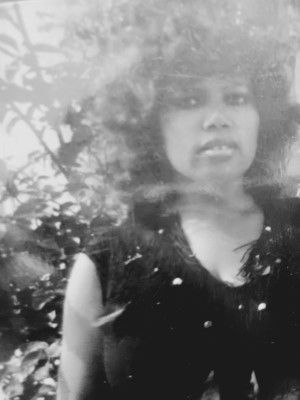
Connie Johnson
Los Angeles, 1981
.
.
___
.
.
Dear Readers:
…..Editing Jerry Jazz Musician can often be a deeply personal experience. With this work I am afforded the privilege of being introduced to hundreds of accomplished writers and poets from all over the world who invite me into their artistic realm, allowing me a view of their interior world, the characters and challenges impacting it, and their passion, vulnerability, and soul.
…..Earlier this year I began receiving jazz poetry from the Los Angeles-based poet Connie Johnson, whose initial submissions revealed personal memory, complexity, and hope within her inventive and graceful honoring of historic jazz musicians and the culture they helped shape. For example, one of her poems contained this gorgeous observation on life:
Maybe I don’t want to tell you
All of my secrets, like how amazing I find it
That life can be distilled into one golden wail of
A Billy Strayhorn declaration. Everything
Is elementary, my dear
I want something to live for.
…..As often happens when I read work of this quality, I anticipated receiving more submissions from Connie. And over the next several months they arrived; consistently fine poems on artists like Armstrong, Ellington, Waller, Simone, Monk, Bearden, and Hughes, making clear her gift for creating biography – and often autobiography – within poems that expose readers to the human qualities of such saintly artists while uncovering her own reverence for them. She tells her story, within theirs.
…..Connie Johnson is a remarkable jazz poet, and while I have published her work in collections and on occasion individually, after having appreciated so many of her poems I felt that an “album” of her poetry – which Connie selected – woven among her audio readings, a personal narrative of her journey and music she considers significant to it would provide readers the chance to also experience the full value of her gifts.
…..To get to know her as I have.
.
Joe Maita
Editor/Publisher
.
.
.
.
___
.
.
In a Place of Dreams:
Connie Johnson’s album of poetry, music, and life stories
.
.
(To distinguish from her poetry, Connie’s personal narrative is italicized throughout the album)
.
.
.
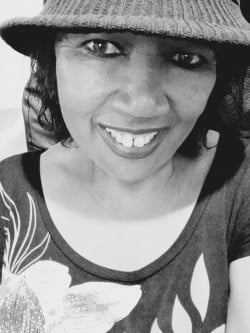
…..
…..Back when other kids my age were listening to Motown, it was jazz titans like Louis Armstrong, Duke Ellington, and Billie Holiday who particularly resonated with me. I write poetry about jazz because it’s a genre of music that I deeply respect and admire.
…..For decades I didn’t do any creative writing at all, but it was an amazing visitation dream I had in 2020 that made me see that I was short-changing myself by not doing this. There are topics that I turn to repeatedly in my work: Music, Love….and New Orleans (because although I was born and raised in Los Angeles, my heart and soul mostly reside in NOLA).
…..Creatively-speaking, if you’ve moved me to amazement or goosebumps, I’m probably going to write a poem about you. Anyone who is impactful in the art that they create, they deserve to have a poem written about them. Three muses that I return to over and over again are Ella Fitzgerald, Billie Holiday and Nina Simone. If I could ever write anything that approaches the wonder of Ella’s voice on “How High the Moon” and “Air Mail Special,” or Nina’s treatment of “I Loves You, Porgy,” I would feel: mission accomplished. I have a long way to go to ever reach that, but it’s the journey that gives me purpose.
…..And joy.
.
.
Listen to the 1938 recording of Louis Armstrong performing “When the Saints Go Marching In” [Universal Music Group]
.
.
In the New Orleans That I Know
………………..“You blows who you is”
…………..– Louis Armstrong
And all that
That encompasses:
Trauma, despair and all the
Unanswered prayers
In between
In the Church of Our Eternal Regrets
We speak in tongues but you can still
Decipher the meaning; we invent the
Names for ourselves that describe us:
Blue black
High yella
Redbone
And in the pure poetry of what
Binds us, we’re ancestral; we’re
9th Ward celestial
….who we is
The blues that infuses
The jazz that we play
…who we is
The hurricane of grief
That feels ever-lasting
….who we is
The bodies cut loose;
We still answer the call
….who we is
The call and response
Of all that’s eternal
…who we is
The gallop we take
Thru all jubilation
….who we is
A ’46 Henri Selmer
B-flat in the hands of
The saints
….who we is
The timing, the rhythm
Boundless, immaculate!
We are ancestral choruses
Of voices that never die
.
.
_____
.
.
…..
…..My parents met in California after migrating here from Louisiana and Texas. Due to redlining back in the ‘50s, there were areas in Los Angeles where Black people couldn’t purchase homes. I was born in South Central Los Angeles and spent most of my early years there. As an only child I was quiet and really shy. On the other hand, I also had lots of curiosity about life and a big imagination.
…..We didn’t live far from Central Avenue and the Dunbar Hotel, both regarded as the hub of the jazz scene in those years. Louis Armstrong, Duke Ellington, Ella Fitzgerald, Billie Holiday, Cab Calloway, Fats Waller, and Lena Horne all played at the Dunbar. Big names like Langston Hughes, Marilyn Monroe, and Mickey Cohen would come to 42nd and Central Avenue (known then as “Little Harlem”) to party and listen to live music. Back then it was the heart and soul of Black culture and society.
.
.
_____
.
.
The Truth of a California Sun
“I spend a lot of time, just kind of surfing
around in my own consciousness, my own
imagination, searching for a place to go”
…………– Kamasi Washington
I listen to you
In Compton as I grab some paints to render
The likeness of Coltrane, poetry in the palette
And in the warm, communal place of the spirit
As I sit front row
In a gospel storefront church on
Vermont Avenue, Truth is in my
Sacred prayer book & in my
Upraised hands
I stroll with purpose
Starting out in Leimert Park; somehow I arrive
In Boyle Heights, Truth in my headphones and
In my measured footsteps
In the darkened hours of
Midnight, my soul spends the night
In the Dunbar Hotel, Truth on my night
Stand, and newly imagined West Coast
Jazz in my ears
A different template
Tenor saxophonic: always searching for
Truth; born in South Central L.A., a place
Rendered incandescent, opulent. I debate
On whether to dip a toe into the Pacific
Or become completely submerged
Surfing waves of imagination
Waves of melodic poetry
You make me think of Coltrane
After hours of meditative conversation;
In dialects of complexity, you are golden
A California sun, smiled upon by the elders
In a harmonic meeting place where jazz is
Collaborative: Your palette is spiritual,
Timeless; the Truth
.
Listen to the 2017 recording of Kamasi Washington performing “Truth” [Beggars Group Digital Ltd.]
.
.
Louis: the King of New Orleans
Daddy Jazz
Louisiana man of the hot fives & sevens
Sound of the workaday folks, the dock workers
And domestics, hustlers and scramblers, the
Wagon drivers and the good time women
NOLA life in all its beautiful
And painful complexity
Sweet Papa Dip
A great grandson of slaves
You are the thirteen blocks of
Bourbon Street, making a way from no way
Mostly self-taught and ragging those tunes,
Embellishing the melodies. Nimble-minded,
With just a 5th grade education…you innovative
Genius! On your horn you showed them how
To swing that music, hit those forty-five
High C’s and follow them with a
High E-flat
Spectacular Pops!
Dazzling innovator
Architect of modern jazz in the
Way you finessed those hot melodies
Even Dizzy confessed: “no him, no me”
Dazzling them in Africa,
Playing before kings and queens
In Europe; some called you the
Ambassador of Jazz, but you dug it
The most when dubbed Zulu King
Of Mardi Gras, your gravelly voice a
NOLA billet-doux that you’d sign:
“Red beans and rice-ly yours”
An extension of your trumpet, you riffed that
Scat to the next level. O Jazz Cartographer!
Designing the map for all others to follow…
Perfect pitch, high notes so precise — Blacks
And Blues so modern even Miles proclaimed:
“You can’t play anything on the horn that
Louis hasn’t played”
And your smile!
A triumph over strife
There’s NOLA in the way that you
Summarized: “What we play is
Life”
.
___
.
Remembering Duke Ellington
..….“Music is how I live, why I live,
and how I want to be remembered”
………..– Duke Ellington
It was in my solitude that I
Discovered the Duke, jazz like
Elegant love letters addressed to
A sophisticated lady.
Dapper Duke
Musical revolutionary
Categories defied by your
Harlem stride; chromesthesia
In the colors of your sound:
Black
Beige
Brown
My mood swings in colors; my mood
Is indigo. Like dapper Duke, your music
A form of activism:
“I merely took the energy it
Takes to pout and wrote
Some blues”
Blues, tans and browns
Inherent in the swing of your sound
My own mood is indigo, sentimental:
Like a sophisticated lady
Who’s got it bad as she addresses you
Remembers you, still loving you
Madly.
.
Listen to Connie Johnson read “Remembering Duke Ellington”
.
.
Fats: As I Stride
Did I tell you about the time
I got kidnapped for Al Capone’s delight,
Pleasure in the keys in a 3-day birthday
Jamboree? Even mobsters believe in making
The joint jump! My joy effervescent, my hands
Larger than life: my rhythmic left
My syncopated right
I don’t blame them, goodness knows
Who could resist how I made the keys
Dance; I made ‘em sing, my googly eyes a
Spit in the eye in the Age of Jim Crow. I may
Be black & blue, but I just speakeasy until the
Pain rolls on thru
Stride for stride, inspiring Yardbird’s
Scrapple From the Apple: tasty rhythm
On the left; syncopation on the right!
It was 1929
At Connie’s Inn in Harlem
Where I debuted my soft shoe confection
Step lightly, gents! We ignore those consumed
By jealousy! I’ve left you a musical legacy
On these keys abundant, syncopated
Larger than life: “aw yeah, looka here
Looka here,” I hand you
Honeysuckle Rose!
.
___
.
Maybe Marilyn
In the hundreds of hours
She spent listening to Ella
Studying her timing, articulation, phrasing
Maybe she sensed a kindred spirit also born
In poverty and abuse. Cinematic bombshell
Listening to the elegance of Ella’s
‘S Wonderful
But Not For Me
And when they finally met
And Ella told her how she longed to sing
“In one of those fancy places,” maybe Marilyn
Immediately thought of how she could make that
Happen for her in the racially charged ‘50s
At the world famous Mocambo
Sunset Strip nitery, L.A. noir and
Playground to the stars:
Howard Hughes, Bob Hope
Charlie Chaplin, Bogie and Bacall
To be a Negro in the ‘50s and play the Mocambo
The prerequisite was glamour, like that of
Lena Horne and Eartha Kitt: svelte curves
In a decadent playground
Maybe Marilyn thought, what could be more
Glamourous than Ella’s Oh, Lady, Be Good!
And They Can’t Take That Away From Me?
With one phone call she made it happen
Promising to attend every night Ella was
Booked and to bring plenty of
Fancy stars with her
Friendship
In a Jim Crow era
Already a star, but one phone call changing
The trajectory of her career, Ella said Marilyn:
“was ahead of her time and she didn’t even
know it”
Maybe Marilyn did know it;
Maybe she didn’t. Maybe all
That matters was the boldness
Of a gesture too marvelous
For words
.
___
.
Vegas
“If it wasn’t for hustlers, gangsters
and gamblers, there’d be no jazz” – Betty Carter
Okay, so now I just want to drive to Vegas
though money has never been the objective
euros francs rubles yen what’s that again?
None of it makes cents to me
I just like to wander thru casinos & whisper
to each blackjack bandit:
…………………….yr alone
…………….& yr alone
………& yr alone
It comforts me.
So don’t hold all the ways
in which I’ve lost
against me
jazz lacing through tears during
each of my acoustic solos
I only came here to
disappear
.
…………..Previously published in Shot Glass Journal, Issue #40
.
___
.
In a Place of Dreams
“Sometimes I think the whole of my life
has been a search to find the one place
………………….I truly belong…”
………….– Nina Simone
Dreams…
Wafting thru the trees
A proliferation of greenery
Parc du Champ de Mars and I just saw
The name of Alexandre Dumas engraved
On the Eiffel Tower: The Three Musketeers
A swashbuckled “one for all, all for one”
And I should read that book one day.
Dreams…
Of a late afternoon in Paris
I sit on a Parc du Champ de Mars bench; two
Women sit down next to me, chattering away to
Each other in French. We sit, sun-lit, and practically
Thigh to thigh: One for all, all for one? And while it
Feels like an invasion of my personal space,
This is Paris and this is a moment serene
Surrounded by a myriad of trees and the
Birds that my father would feed
If he were here.
Dreams…
And in this moment I think of Nina Simone:
Singular expatriate, so many gestures feeling
Invasive, jarring, even in a place as
Beautiful as Paris.
My story’s not here
Nor that of my father’s. But as the setting sun
Feels like birdsong in a place that is a
Profusion of roses, symbolic of hope…
I dream; I always continue
To dream.
.
.
_____
.
.
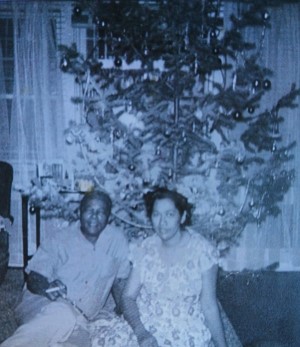
Nathaniel and Cora Lee Johnson, 1956
.
…..My father was born in Tallulah, Louisiana and grew up with next to nothing, but it didn’t destroy his spirit; it made him tender-hearted. Though he was a good provider, my father struggled with reading. That’s because he’d had to drop out of school at an impossibly young age in order to work and fend for himself in the world. When he met my mother, he said it was like someone handed him a million dollars. That’s the kind of love I grew up witnessing.
…..My mother had wanted to name me Natalie, because it sounded like a combination of my father’s name and hers. But my dad was a huge baseball fan, so he had a different idea. My hunch is that he named me Connie Johnson in honor of the famous Negro Baseball League pitcher. It didn’t matter if he’d had a son or a daughter; his child was going to be named after someone who attained big things in life.
…..My mother had a little college under her belt, having briefly attended Prairie View A&M University in Texas. She was a voracious reader and she instilled that in me. One of my earliest memories is of sitting on her lap as she read the Sunday Funnies to me, and I’m reminded of what the poet Strickland Gillilan wrote:
…………………………Richer than I you can never be –
………………..I had a Mother who read to me
…..My father started to bring home comic books for me to read, mostly ones about cowboys and Superman; my mother subscribed to Highlights, a children’s magazine with the philosophy that “children become their best selves by developing their creativity and imagination.” Aspirational dreams, that’s what my mother had for me.
.
.
_____
.
.
A Harlem Photograph
“You can see the picture before it’s taken;
then it’s up to you to get the camera to see”
……………………– James Van Der Zee
Speak to me so I can shiver:
Aspirational magic, dammit!
I’m magic.
Evoke James Van Der Zee
A stylized portrait, negative
Manipulated to make you
Feel seen.
Visual culture, my heart’s
Harlem touchstone. Speak to me with
“Billie’s Blues” as the backdrop
I’m magic!
Ghosts that inhabit jazz are all
A part of this vision, as Van Der Zee
Enhances our truth with his lens;
With sighed resignation
You might claim:
I ain’t good-looking
& my hair ain’t curled…
O baby, shush that!
Come pose and don’t deny magic
Picture us both in a Striver’s Row
Of mobility. Speak to me like the
12-bar aristocrat that you are.
.
___
.
Romare Bearden: The Pulse
“There’s always a pulse there.
There are times there’s nothing but the pulse….
Bearden’s paintings are like that”
…………………– Max Roach
Sounds, rhythms
Colors, silences…
Jazz in the pulse
Cerebral, spacing lines
And colors
Jazz on the canvas and all that it
Implies. Blues repetition collage/painted
Onto It. A form of visual jazz, the riffs
Of a theme
In his studio above the Apollo
In the epicenter of it all, jazz
Seeping thru the walls and the
Floorboards
Jazz made visible in cubist shapes
The call & recall of improvisation
Cerebral/intentional/collaborative:
“I jam with you at the Savoy;
I sail with you on a Seabreeze.
I vibe your Paris Blues because I like
to travel; together we watch the good
trains roll by.”
Always in motion
Call and recall in pulsating jazz
Parlance: “I slap Seventh Avenue with
The sole of my shoe” to get to you
Pulsating…
Pulsating…
Always: JAZZ
.
.
_____
.
.
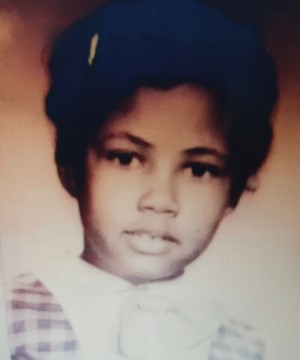
Connie Johnson, 1958
.
…..I attended Menlo Avenue Elementary School and one day a famous writer from Harlem, New York came to speak to us about American history and civil rights. After his presentation there was an empty chair next to him at a table where he signed autographs for the students. I had never heard of James Baldwin, but I wanted to sit next to him and for once I didn’t let my shyness stop me. He didn’t seem insulted by the unabashed way in which I stared at him, fascinated. I was just a curious kid and he was kind. He looked me squarely in the eyes; and he smiled.
…..After my mother bragged to a neighbor about how I loved to read anything I could get my hands on, that neighbor gifted me with “A Child’s Garden of Verses,” a book of poetry by Robert Louis Stevenson. Later, the first poem I ever felt drawn to memorize was “Dream Variations,” by Langston Hughes. That’s when the seed was planted: “A writer, that’s what I want to be.”
…..In the ‘60s the Black Power movement was in full effect; it did influence me, along with the brass and bravado of other works by Hughes. I was 16 years old when I wrote my first poem and it was published in a small, local newspaper. The opening lines were:
I’m a Black woman, baby…
You better come and check me out,
I can say more with a whisper than
You can with a shout
.
.
_____
.
.
To Langston, With Love
“Jazz is a heartbeat – its heartbeat is yours.
You will tell me about its perspectives when
you get ready”
………………………..– Langston Hughes
When they call you the father
……………………….Of jazz poetry
I would have to agree with that
It’s back in the ‘20s when you
Started to write it, and for that
I will tip my hat.
I might not break my lines like you
But I’m still inspired thru and thru
You called jazz “a montage of a
Dream deferred” for those
Of the darker hue.
You said that jazz is everywhere
Encompassing the rock and the roll
It’s heard in the sound of Billie and Monk
You’d have to say it encompasses the soul.
You can start with the blues
And take it from there; add some Bebop
Boogie and then…No matter how
You decide to anoint it, it’s all
Gonna be jazz in the end.
In the call-and-response
Of your artistry
I could dance to everything that you wrote
Just by the way you’d swing and improvise
You’re the poet I’m always tempted to quote
And if “doing it for the culture” was a person
It would be Langston Hughes without a doubt
The wordplay he wove was so effortless
Isn’t that what being a poet is about?
“Jazz is a heartbeat” …
He often would say and on any day I’d have to agree
It’s the men and women of jazz who inspired him
It’s Langston Hughes who inspires me.
.
.
_____
.
.
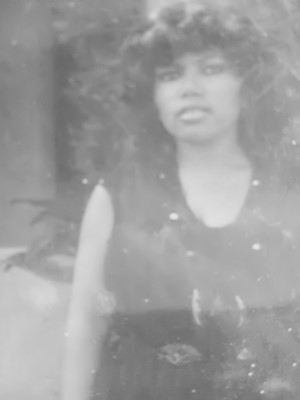
In 1981: The poet at her “Mama’s House”
.
…..As a teenager I didn’t have a ton of actual life experience compared to my peers. I didn’t date; my nose was always stuck in a book! I was 19 years old when I met my first love. He was a young Vietnam vet and an aspiring poet/playwright/publisher. He didn’t live in L.A., so much of our relationship was conducted in letters and in the poetry he wrote for me.
…..Over time, he asked me to send him my own poems, so I sat down in 1976 and wrote several that I drew from my imagination or from the ways in which he had affected me. His dream was to get me published, but some of my poems were so wild, free, and deeply personal that they probably were only intended for an audience of one. I wrote one, though, that was about my mother and it summed up how I felt about the foundation in life that she gave me.
.
.
Mama’s House
It is warm here.
Blues
simmer on the
backburner.
Like caesarian stitches
we wear her
love.
Sewn into warmth
we brave the flamelessness
beyond her door.
She hugs us tight
like promises.
we stride because of
her.
Touching mama
we knead her
according to our
tastes.
She resists.
Firm.
and takes her own
shape.
Feeding on
mother wit
we come away full and
wise
as mama
divides her love in
equal halves.
No one goes away
hungry
from this house.
.
.
_____
.
.
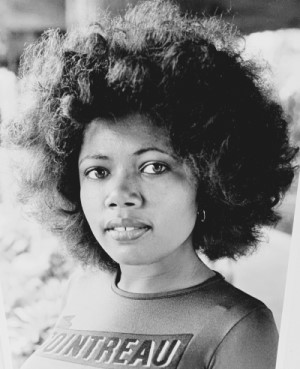
Connie Johnson, 1976
…..With so many miles separating us, in 1976 my poet had another woman in his life; I had another man in mine. “High In Public Places,” “The Moon Within My Hands,” “In the Silence of This Foreign Land,” “The Harvest,” “Where There’s Smoke,” “Hieroglyphics,” “L.A. Woman,” “& Drunken Tourists Bring Cameras to San Francisco,” “Someplace, Not Here,” “After It’s Over”: just a handful of the other poems I wrote that year under my full given name: Connie Sue Johnson. I never go by that, personally or professionally, but in this case and with these particular titles, it felt right.
…..When the door closed on the relationship with my poetry muse, I didn’t feel moved to get any of what I wrote for him published. My major in college was journalism, but poetry never entirely vanished from my mind…
.
.
_____
.
.
I Thought About You
Today I thought about the time I saw
Carmen McRae in a shoe store in
West Hollywood, 20th century siren
But not unapproachable. I thought of
Vinyl records, mood shifting from
Tears to a smile. That’s a gift, her voice
A shadowy dream: (Same old dream…
And approachable, like dreams
Can seem to be
Vinyl record, a penny on the needle to keep it
From skipping. Picture a sequined chanteuse
At the mic and the way she sang the words:
……………………………Same old dream….
It evokes longing, cigarette smoke
Ghosts on a train
Some dreams will out-live us all
But now a good question to ask is:
What do my feet look like in these
High heels with no pedicure?
And does this store carry seamed stockings
Black like I like them?
I like these kinds of distractions
They take my mind off unanswerable dreams
Notes floating like cigarette smoke, fragile steps
In too-tight sequined heels
Originally published in Jerry Jazz Musician; April 30, 2023
.
Listen to Connie Johnson read “I Thought About You”
.
.
Unquenchable
O Afroesque burlesque
stripped down to honey, mellifluous
in all that I want to say to you: I’m the
kicked off stilettos that once pointed to
the east, west and south of your intentions
I travel on foot;
it’ll take me a minute
to reach you
Let me skim the map
of your subtle topography
I’ve been baptized in tears so every
step I take is intentional. I am the wine
you can only find in Sonoma; you are the deep
Bebop blessing of the sip. It must be clear to you
now that I’m unquenchable
Honey
Mellifluous
And you might have to
have to pour into me
forever
.
___
.
This May Only Be A Dream
Envelope me
Use your pen to describe me
I like the way you wrote me into existence
Write me in long hand, you can’t apply
Technology to me. Our love makes more sense
On lined paper, ink-stained, with no auto-correct
Finish my sentences
It’ll all go to waste otherwise
Unfiltered, a pocketful of blackverse
A door left ajar
Just saying goodbye felt like
A generational curse, shedding tears
In the stanzas. (And deferred dreams
Don’t die; they only multiply
It’s called exchange of magic
You can’t steal words I willingly
Gave you. I see the way you still carry me
In this world; do that sweet thing again
Where you conjure me into existence
It’s a writer’s prerogative
Our story in a volume of poetry, sold only
In the bookstore of your mind. Autographed
Decipherable to just a few. Write us down on
Lined paper, old school. End it with the
Sonorous sigh of Johnny Hartman:
“for all we know…”
.
Listen to the 1980 recording of Johnny Hartman singing “For All We Know,” with Joe Wilder (trumpet); Franks Wess (tenor saxophone/flute); Billy Taylor (piano); Al Gafa (guitar); Victor Gaskin (bass); and Keith Copeland (drums). [BeeHive Records]
.
.
The Words We Chose
“The words choose the poet”
………– Quincy Troupe
Homeward, but
Idling at the stoplight
Hip Hop from a neighboring car
Drowning out my Modern Jazz
Suddenly there are your words
From my archival memory:
“I hope there are no
red lights for us”
It was your words that made
Me speed down neon-lit avenues
Every light urging me to “go…go
.…Go!” I could recite every word
That you wrote to me: spirits in the
Ether and salvation in the stanzas
All of what you said to me
Directed my path
Illuminated
And laced with music
Hopeful healing in the stanzas
And all that could be read between the lines
My words are what you carried on your journey;
It’s the unspoken words that could have
Carried us home
.
.
_____
.
.
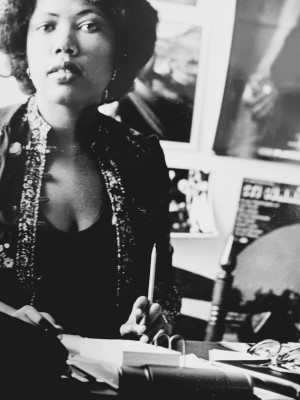
Connie Johnson, offices of Soul Publications, 1977
.
…..Poetry vs Journalism: While I realize now that it never had to be an either/or choice, I decided to focus on journalism. And life moved pretty quickly after that. I dropped out of Cal State University, Los Angeles and served as the editor of Soul Publications for a year. I later freelanced for the Los Angeles Herald-Examiner and its competitor, the Los Angeles Times. I wrote articles that appeared in Billboard, Music Connection, Black Stars (its parent company being the Johnson Publication Company, which also publishes Ebony and Jet), and Players, a men’s magazine once edited by the poet Wanda Coleman.
…..I have no formal training in writing poetry, but probably the best advice for any aspiring poet is from James Baldwin:
………………..…“Read, read, read, never stop reading.
…….And when you can’t read anymore…WRITE.”
.
.
_____
.
.
You Brought Me the Light
Afrique noir
Mirror it back to me
You introduced me to First Light
By Freddie Hubbard
& I can picture you as the teenage boy you were
When you first heard it
1971: (jazz prematurely declared dead
Fusion bringing it back to life
Freddie Hubbard, an iconic resuscitator
Silk my ears & I will pronounce this afrique noir
You can take me lots of places
In eleven minutes
To worlds even beyond Motown/Stax
You already know I’m hip to what’s
Dramatic, tempting & wondrous
There’s room on my record shelf
For even more
I’m ready for some post-bop
In this light bulb moment
& I’d snap my fingers & say “ah ha!”
But I’m too in the zone to utter
The obvious
Jazz: grown & ethereal
Grown & mystic
This is my music now.
.
………………Originally published in Jerry Jazz Musician; April 13, 2023
.
Listen to the 1971 recording of Freddie Hubbard performing “First Light” [Columbia/Legacy]
.
.
And We Know Within Three Notes
“A genius is the one most like himself”
………………………..-Thelonious Monk
So I’m curious
‘Round Midnight
Were you one of those who
Tried to imitate the Melodious One
Who defied margins; the misdiagnosed
Untethered sage?
Poignancy in the humanity
Angularity in language; humor
Trinkle Tinkle: iconic
Unorthodox; harmonically cryptic
That’s right: I Mean You
Hits improvised
Outside the box (where is the box?)
Dangled cigarettes; splayed fingers
All you gave ‘em was Straight
No Chaser
A goatee and beret with some
Bebop in your walk, ready to
Receive what’s been bestowed:
“all ways know”
A philosophy; a way to approach
Both life and music
Free
Genius, Outsider
Sublime; were you tempted
To imitate one who was an
Original all of the time?
Well, You Needn’t
.
___
.
Peep This
One note
Filled with Memphis Blues
Spoken so distinctively, honed on
Post – Bebop in Ray Charles’ classroom
Sometimes whispering, always powerful
Joy deliverance on an alto sax
Hank Crawford
I heard him play at the Parisian Room in L.A.
His swinging stamp of jazz, the way he delivered it,
He sang thru his horn in southern
Baptist/post-Bebop bliss
The blues in his DNA
The church in his bloodline
I’m surprised nobody passed the plate on The Peeper,
Its bluesy cry taking us to a different kind of church
Full of sharkskin cool papas in custom-made gators
Not reserved for Sunday
Oh, Hank read that room
Full of sepia-and-bronze thrills, jazz with a
Church house holla, the weight of it and the
Swing so undeniably his
The Parisian Room, now a post office
Named after Ray Charles. But on that night
Yes, Lord! It was the signature of Hank
That delivered
.
.
___
.
.
freedom suite: Haiku
.
A blue note Sunday,
My father in his church suit
Plays some Jimmy Smith
.
Classic John Handy
We dig that jazz/funk hybrid,
Hard work on vinyl
.
Trade these old records
Jazz marked down to four dollars
Genius in my hand
.
A dog-eared copy
Of Downbeat, pages flutter
Ella’s Flying Home
.
Diving underground
Spirits and jazz co-mingle
I can feel you now
.
What’s more free than jazz?
Pinpoints of light surround us
The soul reveals all
.
Essential Coltrane’s
In a Sentimental Mood
Paradise complete
.
………….Originally published in Jerry Jazz Musician; July 5, July 24, and September 27, 2023
.
___
.
I’m Trying to Get to Know You
Tonight it’s about Pushkin
And Bukowski. Let’s share a cab
And discuss poetry with the driver
I might hum a few notes from that
Bit of hard bop I can’t get
Out of my head
Butterfly at me quick, always in my peripheral
Frantic riffs and this tune ain’t for no amateurs
Explosive scales on an east coast cityscape and
A wingspan of deference so bright & breezy
And so…
What do you know about Wayne Shorter?
Hard bop, so precisely. Like a sax-infused
Dream I can’t get out of my head. His
Eighty nine ways of saying:
“I’m making strides to have
dialogue with life”
Let’s talk poetry and everything we know
About all that encompasses life:
I’m trying to
Get to know you
.
___
.
I Have Almost Everything
And everything you say to me is velvet
Enveloped in scat, a language I understand
From the inside of a shot glass. It’s elementary
Feeling sacred. Almost like a benediction
Like Ella, like pearls before all that was
Meant to be mine
Don’t get shy now, sunlight glittering
Off your tongue. That’s a surprise, I thought
You’d be more comfortable with moonlight
Adventurous, feeling more than mysterioso
why can’t i have love like that brought to me?
It’s a reasonable request
Though ordinarily I travel light
Everything I own close at hand
Lacking little, a sacred benediction
And don’t get me started because who says
I want you to know where I’m coming from?
Maybe I don’t want to tell you
All of my secrets, like how amazing I find it
That life can be distilled into one golden wail of
A Billy Strayhorn declaration. Everything
Is elementary, my dear
I want something to live for
.
Originally published in Jerry Jazz Musician; January 20, 2023
.
Listen to Connie Johnson read “I Have Almost Everything”
.
.
_____
.
.
…..It’s taken me many years to really think of myself as a poet. I’ve had to find my own techniques for doing this, and I can understand the approach of Linda Pastan who said that when she was young:
“Poetry kept me company. I read poems as if they were letters written to me, and I wrote poems back as answers.”
…..I truly relate to that.
…..A love for reading…if it hadn’t been instilled in me as a child, I doubt that I would be a writer today. With each poem, I grow in confidence as I am reminded of “Billie’s Blues,” when Lady Day sang:
I ain’t good looking
And my hair ain’t curled
But my mother, she gave me something
It’s going to carry me through this world
.
.
Listen to the 1965 recording of Ella Fitzgerald (with Duke Ellington) performing “I Want Something to Live For” [Universal Music Group]
.
.
_____
.
.
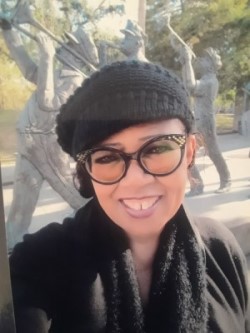
Connie Johnson is an L.A.-based writer who turns to poets like Gwendolyn Brooks, Lucille Clifton, and Audre Lorde when she needs a little inspiration. And she agrees with Clifton who said: “Poetry is a matter of life, not just a matter of language.” Johnson’s poems have appeared or will be forthcoming in Iconoclast, Haight-Ashbury Literary Journal, Jerry Jazz Musician, San Pedro River Review, Shot Glass Journal, Voicemail Poems, Misfit Magazine, Mudfish 23, Cholla Needles, Exit 13, Glint Literary Journal, Rye Whiskey Review and Door Is a Jar.
.
.
.
___
.
.
Click here to read The Sunday Poem
Click here for information about how to submit your poetry or short fiction
Click here to subscribe to the (free) Jerry Jazz Musician quarterly newsletter
Click here to help support the ongoing publication of Jerry Jazz Musician, and to keep it commercial-free (thank you!)
.
___
.
Jerry Jazz Musician…human produced (and AI-free) since 1999
.
.


































Ms. Johnson, this online chapbook (what else would one call it?) is a remarkable creative achievement that brings jazz alive on the page, and lifts a reader’s spirits with its wild imagination, and deep insight into how jazz blesses those who listen to it.
“…jazz blesses those who listen to it”? Yes, I couldn’t agree with you more, Mr Newell.
Thank you very much!